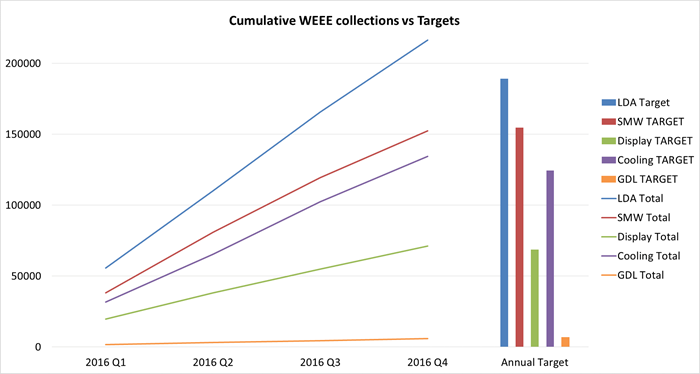The end of year report published by the Environment Agency shows that the total WEEE collected in 2016 was enough to meet the UK target.
However this is not the whole story, as it does not illustrate the true impact on producer obligations or costs.
The WEEE compliance system for 2016 was reeling from a number of factors impacting the collection systems operated by schemes across the UK. These can be summarised as:
- Dual use definitions classing more EEE as household rather than B2B, contributing to greater obligations and distortion of collections (for example IT equipment in small mixed WEEE)
- Alterations to lamps targets caused by large non-compliant businesses joining the system late, impacting the collections of lamps
- Low secondary commodity material prices throughout 2016 affecting evidence costs and influencing the rate of collections (Large domestic appliances)
- Over performing WEEE collection systems in less sought after WEEE streams (for example cooling equipment)
As a result, 581,000 tonnes of WEEE was collected against a target of 544,000 tonnes that on the face of it is a positive story to explain the costs of WEEE compliance to producers and to report back to the EU. However, if we look more closely into the figures there are some streams within the WEEE system that have fared better than others, hiding a story of under and over collection and dynamic markets.
We are pleased to say the impact to Ecosurety has not been negative, despite these results across the UK. Our collection systems within Small Mixed WEEE have expanded year on year as we develop more and more takeback systems with members, retailers and distributors. We are now looking to the 2017 target review (further details to be published shortly) and continue the debate with government to support setting targets that the market can absorb, whilst relying on supporting mechanisms like substantiated estimates and compliance fees only where absolutely necessary.
2016 WEEE Stream collection analysis

Large Domestic Appliances (LDA)
White goods which traditionally have fallen into the WEEE system due to the high metal content, have seen a huge over collection. This may be due to the WEEE system providing a funding stream from producers to recyclers, due to sustained low material prices.
Small Mixed WEEE (SMW)
General household WEEE has always shown reasonable performance, and there was a degree of apathy in the market as to whether all schemes were going to collect enough of this traditionally abundant waste stream. With collections of IT equipment classified as household WEEE under dual use, subsidising most of the target, there was a surprise result at the end of year seeing a slight shortfall in WEEE collected.
Fortunately the compliance fee only approved a matter of weeks ago is a fall back to compliance schemes that did not collect enough, and the fee is used as intended as a top up rather than a dependency alternative to making collections. Even with this financial penalty of a more costly compliance fee, the likely total impact on the £/tonne charged to producers should not be very apparent, assuming the shortfall is spread across many schemes and their producers.
Display equipment
Performance is there or there about, with the shift into flat panel displays becoming predominant for EEE and WEEE. This means the declining WEEE collected target may be coming to an end, supported by the abundance of display equipment WEEE available both through the WEEE system (and paid for by producers) as well as that WEEE not aligned to schemes but paid for by end users.
Cooling equipment containing refrigerants
Another category that is traditionally costly to dispose of, cooling equipment WEEE has been available in abundance but treatment has been difficult with limited recycling capacity in the UK. With new recycling plants soon to open, this should be short lived in 2017. In 2016 however the WEEE system served its purpose but producers are likely to have to pay for more than the collection target WEEE.
LED and Gas Discharge lamps
Lamps are another stream impacted by dual use, but also affected by mid-year target changes from DEFRA, additionally complicated by the big increase in collection targets in 2014 and 2015. The dynamic nature of the targets, EEE reported and WEEE arising, ultimately made for what is traditionally the most costly waste stream becoming a well sought after source of WEEE due to a stretching target.
Since midway through 2016 it looked likely there would be an insufficient amount of lamps collected, which further injected scarcity into the market and the cost of WEEE evidence, but boosted the demand for this waste, drawing it into the producer responsibility system. This is the principle on which the WEEE system should work, with targets driving WEEE into the producer funding system.
However, in this instance the target did not appear to be achievable, without the need for reliance on the compliance fee. In 2016 the 800 tonne shortfall is equivalent to a huge number of individual lamps. Again, we're likely to see rectifying targets for 2017 and the impact could have cost implications starting in 2017 with a lack of WEEE arising early on in the year.
To discuss how this news may affect your WEEE compliance, please contact our team on 0333 4330 370 or email info@ecosurety.com.

Robbie Staniforth
Innovation and Policy Director
Robbie is innovation and policy director at Ecosurety. Having spent years building an intimate understanding of the industry’s policies and politics, he uses this knowledge to help shape new legislation and oversees Ecosurety’s growing portfolio of cross-industry innovation projects including Podback and the Flexible Plastic Fund. He has worked closely with Defra during the most recent packaging consultations, outlining the impacts and required transitional arrangements of the UK’s new EPR system and is a member of the government’s Advisory Committee on Packaging (ACP). He is also a spokesperson for the company and regularly uses his influence to communicate the importance of environmental responsibility to external stakeholders.

Useful links
The recently published Q3 collection data indicates a steady progression toward the annual target, currently reaching 76%.
Read More >>In the second quarter of 2023, the WEEE collection figures show that a total of 118,953 tonnes of WEEE has been collected from households across April – June, which is a 3% increase compared to Q1 collections.
Read More >>Across the first quarter of 2023, a total of 120,433 tonnes of household WEEE has been collected, showing a slight increase of 562 tonnes compared to WEEE collected in Q1 2022.
Read More >>Latest News

Q2 2024 recycling data shows strong performance in H1
By Sam Marshall 24 Jul 2024
Ecosurety continue to step up for refill and reuse
By Victoria Baker 24 Jun 2024
Ecosurety renews B Corp™ certification with flying colours
By Louise Shellard 11 Jun 2024
